Commodity flow or domestic trade refers to the flow of commodities through the water, air and rail transport systems in the country. Data on the inflow and outflow of commodities in the different regions of the country are used to construct interregional and inter-industry relation tables. These serve as bases in the formulation and implementation of various regional development programs like countryside development and port planning.
Quantity and value of domestic trade increased
The total quantity of domestic trade in the second quarter of 2004 increased by 32.2 percent, resulting to 6.16 million tons from 4.66 million tons registered during the same period of last year. Most of the commodities were transported via water comprising 99.8 percent in the second quarters of both years 2003 and 2004.
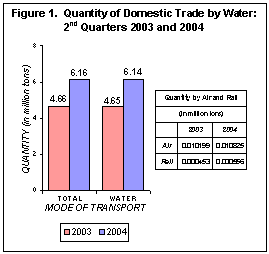
Likewise, the total value of commodities traded increased by 4.6 percent from P85.36 billion in the second quarter 2003 to P89.25 billion in the same period of 2004. The bulk of commodities were traded via water, with shares of 99.6 percent during the second quarters of 2003 and 2004.
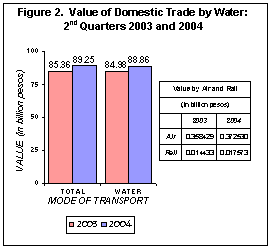
Food and live animals dominated the domestic trade
Among the commodities that flowed throughout the country in the second quarter of 2004, food and live animals contributed the largest total value amounting to P22.28 billion (25.0%). Mineral fuels, lubricants and related materials was next with P20.74 billion (23.2%). Machinery and transport equipment came third with P16.92 billion (19.0%). Animal and vegetable oils, fats and waxes provided the least value of P803.05 million (0.9%) (See Table 1).
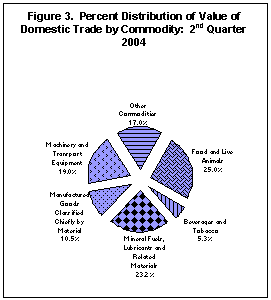
Food and live animals likewise dominated the domestic trade in the second quarter of 2003 with a share of 27.8 percent (P23.76 billion) of the total value. Machinery and transport equipment followed with a 19.4 percent share (P16.53 billion). Mineral fuels, lubricants and related materials was next with a share of 16.9 percent (P14.43 billion). Contributing the least value of only P427.68 million (0.5%) was animal and vegetable oils, fats and waxes (See Table 1).
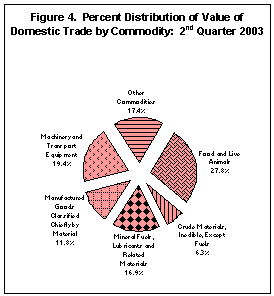
National Capital Region accounted for the largest domestic trade share
Most of the traded commodities in the second quarter of 2004 came from the National Capital Region (NCR) with value of domestic trade amounting to P19.80 billion (22.2%). Central Luzon was next with P18.46 billion (20.69%). Northern Mindanao was third, contributing P8.48 billion (9.5%). Eastern Visayas followed closely with P8.34 billion (9.3%). Contributing the least domestic trade share was Cagayan Valley with only P72 thousand.
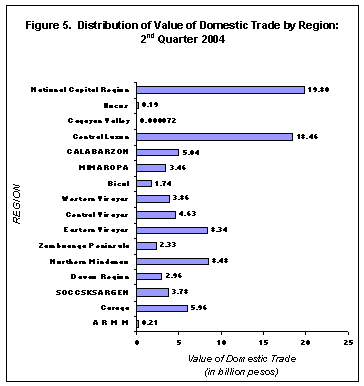
Likewise, during the second quarter of 2003, NCR had the highest domestic trade share at P22.67 billion (26.6%). Central Luzon remained the second highest contributing region with a total value of P14.81 billion (17.4%). Central Visayas was at third place with P11.02 billion (12.9%). Cagayan Valley remained the least contributing region with only P73 thousand domestic trade share.
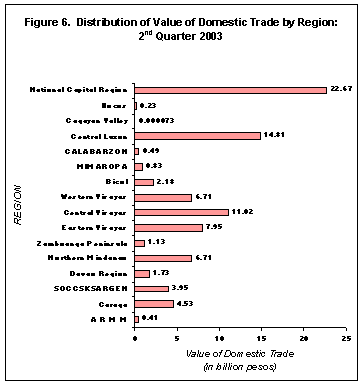
Central Luzon posted favorable trade balance
In the second quarter of 2004, Central Luzon posted the most favorable balance of trade at P17.90 billion. Other regions with more than a billion positive trade balances were Eastern Visayas (P2.83 billion), SOCCSKSARGEN (P2.71 billion), Northern Mindanao (P1.72 billion), and MIMAROPA (P1.60 billion). Inflows for Central Visayas amounted to P14.86 billion resulting to an unfavorable balance of trade of -P10.23 billion. Other regions with more than a billion negative trade balances amounting to -P7.88 billion, -P4.58 billion, and -P3.06 billion were NCR, Western Visayas, and Caraga respectively.
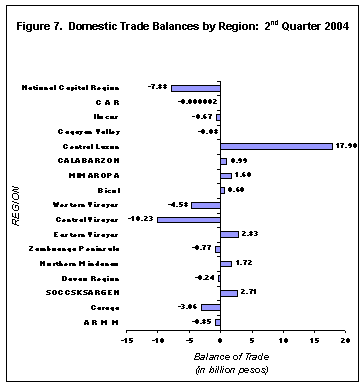
For the same period in 2003, Central Luzon also realized the most favorable trade balance at P14.19 billion. Other regions with more than a billion positive trade balances amounting to P2.16 billion, P2.13 billion and P2.07 billion were SOCCSKSARGEN, NCR, and Eastern Visayas, respectively. On the other hand, Caraga suffered an unfavorable balance of trade of -P3.68 billion.
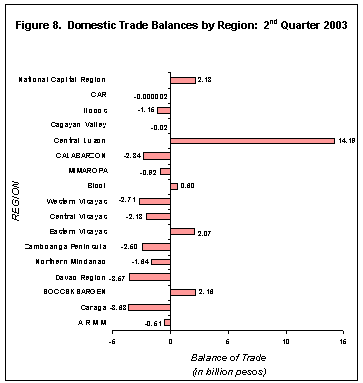
Source: National Statistics Office
Manila, Philippines
